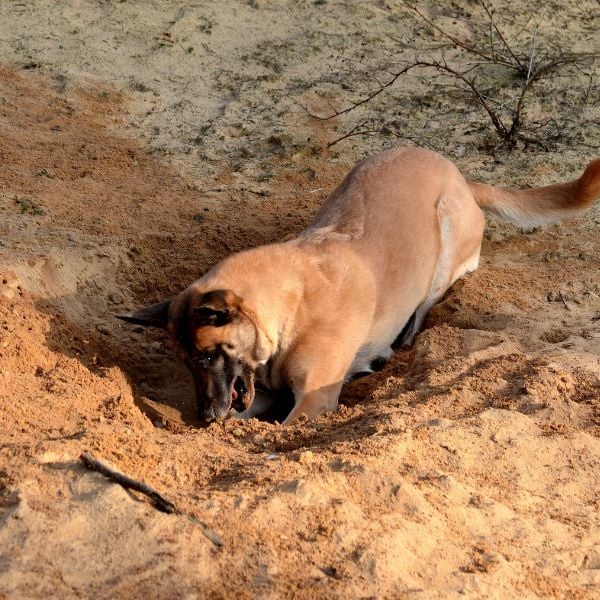Your dog has been diagnosed with valley fever. Understanding the cause of the disease will help you know why aggressive and long-term treatment is essential for your dog’s recovery.
The following information should give you an idea of what valley fever is, what to do, and how you can best prevent it.
Quick Links

The low desert regions of Arizona, Utah, Nevada, New Mexico, southwestern Texas, and the central desert of California are the primary areas where dogs contract valley fever. Recently, the fungus was found in south-central Washington. There are also parts of Mexico (northwestern) and Central and South America where it is common as well.
Each year, in the Arizona counties of Pima, Pinal, and Maricopa, about 6% to 10% of dogs become sick with valley fever.
Our mission is to help save dogs' and cats’ lives through our educational content. To support our efforts, this page may contain affiliate links. We earn a commission for qualifying purchases – at no cost to you.
The disease got its name from its discovery in the San Joaquin Valley of California.
Coccidioidomycosis (aka cocci), which is the medical term for the disease, is a fungal infection that affects humans, dogs, cats, llamas, non-human primates, horses, cattle, zoo animals, fish, marine animals, and other wild animals.
Valley fever is not contagious. The infection cannot be spread from person to person, dog to dog, or between humans and animals.
Dogs are very susceptible to infection with valley fever since they can potentially inhale lots of spores when they dig in the dirt and sniff the ground.
Typically, symptoms are noticed about 3 weeks after infection. But it is important to be aware that the organism can lay dormant (inactive phase) in your dog’s body for up to 3 years before symptoms occur.
As the symptoms are vague and common for many diseases, your veterinarian will determine the severity of the disease based on Titer tests (the higher the titer, the more severe the disease).
Valley fever is a fungal infection caused by coccidioidomycosis.
Coccidioides (the fungus) lives and grows in dust and soil. It grows best after heavy rainfall, and the spores spread through the air most effectively during hot and dry conditions.
Unfortunately, no commercially available tests detect Coccidioides in the soil.
Inhaling the spores is how dogs get the disease.

If your dog is diagnosed with valley fever, it is important to give them the antifungal medications prescribed for the entire length of treatment (6 to 12 months), even if they seem to be improving.
It is important to continue medications even longer if the disease has spread to their bones, skin, or internal organs.
Commitment to life-long treatment is imperative for those dogs that have their central nervous system affected by the disease. Without life-long treatment, symptoms are likely to recur.
If this disease is left undiagnosed or treated, especially the disseminated form, some dogs can die.
Medication, often bought at a human pharmacy, can be quite expensive. Some people have found great discounts using the free resource GoodRx.
Your veterinarian may prescribe additional medications, such as cough suppressants, pain medications, or appetite stimulants, based on the location of the infection and presenting symptoms.
To help provide further comfort to your dog, especially for those with swollen and painful joints:
Typically, your dog will start to feel better about 1 to 2 weeks after starting treatment with an antifungal medication.
A titer test is used to determine if your dog is making antibodies against the fungus that causes valley fever. The higher the initial titer, the more severe the disease.
During the course of treatment, it is important to follow your veterinarian's recommendation to have periodic antibody titer tests. These tests are essential to determine that your dog is improving (the titer is reducing with time) and when the medication can be stopped (when the titer is negative).
You want to notice improvement in symptoms about 1 to 2 weeks after starting treatment. When your dog doesn’t respond to the antifungal medications or areas of the body other than the lungs are affected (especially the brain), your dog will not show improvement as expected within 1 to 2 weeks. Your pet's symptoms will worsen, and additional symptoms are likely to develop based on where the fungus affects your dog.
If you do not observe improvement in your dog’s symptoms or other symptoms develop, contact your veterinarian for further treatment. Hospitalization and supportive care may be necessary.

The best way to prevent re-infections is to avoid your dog breathing in dust as much as possible, especially in areas where valley fever is common.
In areas with high valley fever rates, keep pets indoors as much as possible, especially on windy days and during hot and dry weather.
Attempt to keep your dog from digging or sniffing around rodent hole dirt when outside. Dogs are naturally curious, and like messing with those areas, and in the process of sniffing and digging, they can inhale large numbers of spores. Additionally, rodents can serve as a reservoir for the fungi that cause valley fever.
Avoid walking your dog near areas where there is loose dirt. This includes construction areas, excavation sites, areas where dirt is being moved (e.g., farming) or landscaping is occurring.
Since the fungus lives in spotty areas and can live up to 12 inches deep into the ground, treating the soil isn’t practical; however, attempts to reduce dust can be beneficial. To reduce dust, add ground covering to your property. This can include grass, plants, deep gravel, mulch, or other dust-controlling covering.
There is a vaccine under development, but it isn't available yet. This can be very beneficial for dogs living in areas with high rates of valley fever or traveling through such areas.
The Pet InfoRx® is made possible, in part, through our partnership with AlignCare®.


© Preventive Vet. All rights reserved. PreventiveVet.com
